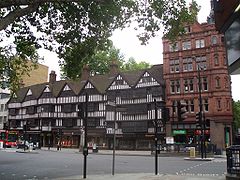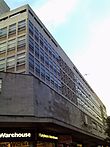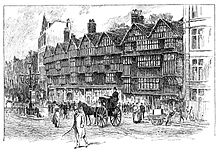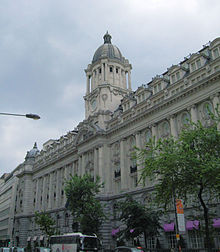- Holborn
-
Coordinates: 51°31′02″N 0°07′06″W / 51.5172°N 0.1182°W
Holborn 
Staple Inn, High Holborn
 Holborn shown within Greater London
Holborn shown within Greater LondonOS grid reference TQ305815 London borough Camden Ceremonial county Greater London Region London Country England Sovereign state United Kingdom Post town LONDON Postcode district WC1, WC2 Postcode district EC1 Dialling code 020 Police Metropolitan Fire London Ambulance London EU Parliament London UK Parliament Holborn and St. Pancras London Assembly Barnet and Camden List of places: UK • England • London Holborn (
 /ˈhoʊbərn/ hoh-bərn)[a] is an area of Central London. Holborn is also the name of the area's principal east-west street, running as High Holborn from St Giles's High Street to Gray's Inn Road (the junction being roughly where Holborn Bar — the entrance to the City of London — was) and then on to Holborn Viaduct. The street since boundary changes in 1994 runs along the boundary between the London Borough of Camden and the City of London; previously the boundary was less obvious in the area and crossed the street at Holborn Bar.
/ˈhoʊbərn/ hoh-bərn)[a] is an area of Central London. Holborn is also the name of the area's principal east-west street, running as High Holborn from St Giles's High Street to Gray's Inn Road (the junction being roughly where Holborn Bar — the entrance to the City of London — was) and then on to Holborn Viaduct. The street since boundary changes in 1994 runs along the boundary between the London Borough of Camden and the City of London; previously the boundary was less obvious in the area and crossed the street at Holborn Bar.Contents
History
Toponymy
The area's first mention is in a charter of Westminster Abbey, by King Edgar, dated to 959. This mentions "the old wooden church of St Andrew" (St Andrew, Holborn).[1] The name Holborn may be derived from the Middle English "hol" for hollow, and bourne, a brook, referring to the River Fleet as it ran through a steep valley to the east.[1][2] Historical cartographer William Shepherd in his Plan of London about 1300 labels the Fleet as "Hole Bourn" where it passes to the east of St Andrew's church.[3] However, the 16th century historian John Stow attributes the name to the Old Bourne ("old brook"), a small stream which he believed ran into the Fleet at Holborn Bridge, a structure lost when the river was culverted in 1732. The exact course of the stream is uncertain, but according to Stow it started in one of the many small springs near Holborn Bar, the old City toll gate on the summit of Holborn Hill.[2][4] Other historians, however, find the theory implausible, in view of the slope of the land.[5]
Local governance
It was then outside the City's jurisdiction and a part of Ossulstone Hundred in Middlesex. In the 12th century St Andrew's was noted in local title deeds as lying on "Holburnestrate"—Holborn Street.[6] The original Bars were the boundary of the City of London from 1223, when the City's jurisdiction was extended beyond the Walls, at Newgate, into the suburb here, as far as the point where the Bars where erected, until 1994 when the border moved to the junction of Chancery Lane. In 1394 the Ward of Farringdon Without was created, but only the south side of Holborn was under its jurisdiction with some minor properties, such as parts of Furnival's Inn, on the northern side, "above Bars". The rest of the area "below Bars" (outside the City's jurisdiction) was organised by the vestry board of the parish of St Andrew.[7]
The Holborn District was created in 1855, consisting of the Glasshouse Yard, Saffron Hill, Hatton Garden, Ely Rents and Ely Place, St Andrew Holborn Above the Bars with St George the Martyr and St Sepulchre. The Metropolitan Borough of Holborn was created in 1900, consisting of the former area of the Holborn District and the St Giles District, excluding Glasshouse Yard and St Sepulchre, which went to the Metropolitan Borough of Finsbury. The Metropolitan Borough of Holborn was abolished in 1965 and its area now forms part of the London Borough of Camden.
Local politicians include the Rt. Hon. Frank Dobson MP, the Labour Party Member of Parliament for Holborn and St Pancras, and three ward councillors for Holborn and Covent Garden: Cllr Julian Fulbrook, Cllr Sue Vincent and Cllr Awale Olad also of the Labour Party.
Urban development
In the 18th century, Holborn was the location of the infamous Mother Clap's molly house but in the modern era High Holborn has become a centre for entertainment venues to suit more general tastes: 22 inns or taverns were recorded in the 1860s and the Holborn Empire, originally Weston's Music Hall, stood between 1857 and 1960, when it was pulled down after structural damage sustained in the Blitz. The theatre premièred the first full-length feature film in 1914, The World, the Flesh and the Devil, a 50-minute melodrama filmed in Kinemacolour.[8]
Charles Dickens took up residence in Furnival's Inn, on the site of the former Prudential building designed by Alfred Waterhouse now named "Holborn Bars". Dickens put his character "Pip", in Great Expectations, in residence at Barnard's Inn opposite, now occupied by Gresham College.[9] Staple Inn, notable as the promotional image for Old Holborn tobacco,[10] is nearby. The three of these were Inns of Chancery. The most northerly of the Inns of Court, Gray's Inn, is in Holborn, as is Lincoln's Inn: the area has been associated with the legal professions since mediaeval times. Subsequently the area diversified and become recognisable as the modern street. A plaque stands at number 120 commemorating Thomas Earnshaw's invention of the Marine chronometer, which facilitated long-distance travel. At the corner of Hatton Garden was the old family department store of Gamages. Until 1992, the London Weather Centre was located in the street. The Prudential insurance company relocated in 2002. The Daily Mirror offices used to be directly opposite it, but the site is now occupied by the J Sainsbury head office.
Modern times
Further east, in the gated avenue of Ely Place, is St Etheldreda's Church, originally the chapel of the Bishop of Ely’s London palace. This ecclesiastical connection allowed the street to remain part of the county of Cambridgeshire until the mid 1930s. This meant that the Mitre Tavern, located in a court hidden behind the buildings of the Place and the Garden was subject to the Cambridgeshire Magistrates to grant its licence.[11][12] St Etheldreda's is the oldest church building used for Roman Catholic worship in London, but this became so only after it ceased to be an Anglican chapel in the 19th century.
Hatton Garden, the centre of the diamond trade, was leased to a favourite of Queen Elizabeth I, Sir Christopher Hatton at the insistence of the Queen to provide him with an income. Behind the Prudential Building lies the Anglo-Catholic church of St Alban the Martyr.[13] Originally built in 1863 by architect William Butterfield it was destroyed in 1941 and a new church was built in the Victorian Gothic style. The current vicar is the Venerable Howard Levett.[14] On the southern side lie Chancery Lane and Fetter Lane.
On Holborn Circus lies the Church of St Andrew, an ancient Guild Church that survived the Great Fire of London. However the parochial authority decided to commission Sir Christopher Wren to rebuild it. Although the nave was destroyed in the Blitz, the reconstruction was faithful to Wren's original. In the middle of the Circus there is a large equestrian statue of Prince Albert by Charles Bacon (1874), the City's official monument to him. It was presented by Charles Oppenheim, of the Diamond Trading Company De Beers, whose headquarters building is in nearby Charterhouse Street.
In the early 21st century, Holborn has become the site of new offices and hotels: for example, the old neoclassical Pearl Assurance building near the junction with Kingsway was converted into an hotel in 1999.
Education
- For education within the Westminster portion of Holborn see the main City of Westminster article.
Transport and locale
Nearest places
Nearest underground and mainline stations
- Chancery Lane
- Covent Garden
- Holborn
- City Thameslink Holborn Viaduct entrance
- St. Paul's
- Farringdon
Notable people
The following is a list of notable people who were born in Holborn or are significantly connected with Holborn.
- Sir John Barbirolli conductor, was born in Southampton Row (Blue Plaque on hotel his father managed)
- Thomas Chatterton (1752–1770), English poet born in Bristol died in a garret in Holborn at the age of 17. A posthumous darling of the Romantics, he is now remembered as 'the marvellous Boy' (Wordsworth). The Victorian Henry Wallis returned to Chatterton's Brooke Street room to paint George Meredith, the novelist, in a now frequently copied pose of the dead poet (Tate Britain).
- Samuel Coleridge-Taylor (1875–1912), composer, born at 15 Theobalds Road. Won international acclaim for his works especially the Song of Hiawatha Trilogy.
- Charles Dickens lived in Doughty Street where there is a museum
- Naomi Lewis (1911–2009), advocate of animal rights, poet, children's author and teacher, lived in Red Lion Square 1935-2009.
- Eric Morley, founder of Miss World was born in Holborn.
- John Shaw Jr - (1803–1870); born in Holborn, Shaw was an English architect of the 19th century who was complimented as a designer in the "Manner of Wren".
- Barry Sheene MBE - (11 September 1950 – 10 March 2003); spent his early years in Holborn, Sheene was a British former World Champion Grand Prix motorcycle road racer.
Gallery
-
The headquarters of J Sainsbury plc at Holborn Circus
-
Staple Inn building near Chancery Lane tube station
-
Entrance to Gray's Inn
Notes
- a. ^ Pronunciation: The authoritative BBC pronunciation unit recommends "ˈhəʊbə(r)n", but allowing "sometimes also hohl-buhrn". The organisation's less formal Pronouncing British Placenames notes that "You'll occasionally find towns where nobody can agree...Holborn in central London has for many years been pronounced 'hoe-bun', but having so few local residents to preserve this, it's rapidly changing to a more natural 'hol-burn'".[15][16] However, Modern British and American English pronunciation (2008) cites "Holborn" as one of its examples of a common word where the "l" is silent.[17] The popular tourist guide The Rough Guide to Britain sticks to the traditional form, with neither "l" nor "r": /ˈhoʊbən/ hoh-bən.[18]
References
- ^ a b Lethaby, William (1902). London before the conquest. London: Macmillan. p. 60.
- ^ a b Besant, Walter; Mitton, Geraldine (1903). Holborn and Bloomsbury. The Fascination of London (Project Gutenberg, 2007 ed.). London: Adam and Charles Black. http://www.gutenberg.org/files/21411/21411-8.txt. Retrieved 13 August 2008.
- ^ Shepherd, William R (1926). Historical atlas (3 ed.). University of London. p. 75. OCLC 253088196. http://lib.utexas.edu/maps/historical/shepherd/london_plan_1300.jpg.
- ^ Strype, John (1720). "Rivers and other Waters serving this City". Survey of London. The Stuart London Project. Online edition: University of Sheffield 2007. http://www.hrionline.ac.uk/strype/TransformServlet?page=book1_024&display=print.
- ^ Lethaby (1902:48)
- ^ Harben, Henry (1918). A Dictionary of London. London: Herbert Jenkins.
- ^ The Parish of St Andrew Holborn pp11-12 Caroline Barron London 1979
- ^ The World, the Flesh and the Devil at the Internet Movie Database
- ^ Chap. 20
- ^ Hibbert, Christopher; et al (1983). The London Encyclopedia (2010 ed.). London: MacMillan. p. 397. ISBN 1-4050-4925-1.
- ^ Vitaliev, Vitali (3 January 2003). "Things that go bump on the map". The Daily Telegraph. http://www.telegraph.co.uk/travel/726471/Things-that-go-bump-on-the-map.html. Retrieved 12 August 2008.
- ^ Hammond, Derek (28 June 2006). "Secret London: Ye Olde Mitre Tavern". Time Out. http://www.timeout.com/london/bars/features/1614.html. Retrieved 12 August 2008.
- ^ St Alban the Martyr accessed 17 May 2007
- ^ The Parish Church of St Alban the Martyr, Holborn, stalbans-holborncom
- ^ Olausson, Lena (2006). "Holborn". Oxford BBC Guide to Pronunciation, The Essential Handbook of the Spoken Word (3 ed.). Oxford, England: Oxford University Press. p. 173. ISBN 0192807102.
- ^ "Pronouncing British Placenames". BBC. 7 March 2007. http://www.bbc.co.uk/dna/h2g2/A19773499. Retrieved 21 November 2009.
- ^ Dretzke, Burkhard (2008). Modern British and American English pronunciation. Paderborn, Germany: Ferdinand Schöningh. p. 63. ISBN 3825220532.
- ^ Roberts, Andrew; Matthew Teller (2004). The Rough Guide to Britain. London: Rough Guides Ltd. p. 109. ISBN 1843533014.
External links
London/Holborn-Clerkenwell travel guide from Wikitravel
- Holborn and Bloomsbury, by Sir Walter Besant and Geraldine Edith Mitton, 1903, from Project Gutenberg
Gates and Bars of the City of London Former gates of London Wall and City bars
Temple Bar · Ludgate† · Holborn Bar · Newgate† · Aldersgate† · Cripplegate† · Moorgate · Bishopsgate† Bars · Aldgate† · (Tower) Posterngate
Listed clockwise from the West
Water-gates: Billingsgate and Dowgate
Bridge-gates: Great Stone Gateway and New Stone Gate
†The six Roman gates
City of Westminster Districts Aldwych · Bayswater · Belgravia · Covent Garden (including Seven Dials) · Fitzrovia · Holborn · Hyde Park · Knightsbridge · Lisson Grove · Maida Vale (including Little Venice) · Mayfair · Marylebone · Millbank · Paddington · Pimlico · Queen's Park · St James's · St John's Wood · Soho (including Chinatown) · Victoria · Westbourne Green · Westminster
Attractions Parks and open spaces Constituencies Bridges Tube and railway stations Baker Street · Bayswater · Bond Street · Charing Cross · Charing Cross railway station · Covent Garden · Edgware Road(Bakerloo line) · Edgware Road (Circle, District and Hammersmith & City Lines) · Embankment · Great Portland Street · Green Park · Hyde Park Corner · Lancaster Gate · Leicester Square · London Victoria station · London Paddington station · Maida Vale · Marble Arch · Marylebone station · Oxford Circus · Piccadilly Circus · Pimlico · Queensway · Regent's Park · Royal Oak · St James's Park · St John's Wood · Temple · Tottenham Court Road · Warwick Avenue · Westbourne Park · WestminsterOther topics People from Westminster (district) · Public art · Schools
List of places in London Major districts Abbey Wood · Acton · Barking · Barnes · Barnet · Barnsbury · Battersea · Beckenham · Bermondsey · Bethnal Green · Bexleyheath · Bloomsbury · Bow · Brentford · Brixton · Brockley · Bromley · Camberwell · Camden Town · Canonbury · Carshalton · Catford · Charlton · Chelsea · Chessington · Chingford · Chislehurst · Chiswick · City · Clapham · Clerkenwell · Cricklewood · Coulsdon · Croydon · Dagenham · Deptford · Ealing · East Ham · Edmonton · Eltham · Enfield Town · Erith · Feltham · Finchley · Forest Hill · Forest Gate · Fulham · Greenwich · Hackney · Hammersmith · Hampstead · Harrow · Hendon · Highams Park · Highbury · Highgate · Hillingdon · Holborn · Hook · Holloway · Hornchurch · Hounslow · Ilford · Isle of Dogs · Isleworth · Islington · Kensington · Kentish Town · Kensal Green · Kilburn · Kingston upon Thames · Lambeth · Lewisham · Leyton · Marylebone · Mayfair · Mitcham · Morden · Muswell Hill · New Cross · New Malden · Orpington · Paddington · Peckham · Penge · Pinner · Poplar · Purley · Putney · Richmond · Romford · Ruislip · Shepherd's Bush · Shoreditch · Sidcup · Soho · Southall · Southgate · South Norwood · Southwark · Stepney · Stoke Newington · Stratford · Streatham · Surbiton · Sutton · Sydenham · Teddington · Thamesmead · Tolworth · Tooting · Tottenham · Twickenham · Upminster · Upper Clapton · Uxbridge · Walthamstow · Wandsworth · Wanstead · Wapping · Wealdstone · Welling · Wembley · West Ham · Westminster · West Norwood · Whitechapel · Willesden · Wimbledon · Wood Green · Woodford · Woolwich
Barking and Dagenham · Barnet · Bexley · Brent · Bromley · Camden · Croydon · Ealing · Enfield · Greenwich · Hackney · Hammersmith and Fulham · Haringey · Harrow · Havering · Hillingdon · Hounslow · Islington · Kensington and Chelsea · Kingston · Lambeth · Lewisham · Merton · Newham · Redbridge · Richmond · Southwark · Sutton · Tower Hamlets · Waltham Forest · Wandsworth · Westminster
University of the Arts London Colleges and
subdivisions
University CampusCamberwell · Charing Cross Road · Clerkenwell · Elephant and Castle · Hackney · High Holborn · Holborn · Merton Park · Millbank · Oxford Street · WimbledonPeopleAcademics · Alumni · Chairman: Sir John Tusa · Rector: Nigel CarringtonOtherAffiliates London Centre for Arts and Cultural Exchange · Universities UK
Categories:- Districts of the City of London
- Streets in the City of London
- Streets in Camden
- Districts of Camden
- Districts of Westminster
- Districts of London listed in the Domesday Book
Wikimedia Foundation. 2010.










